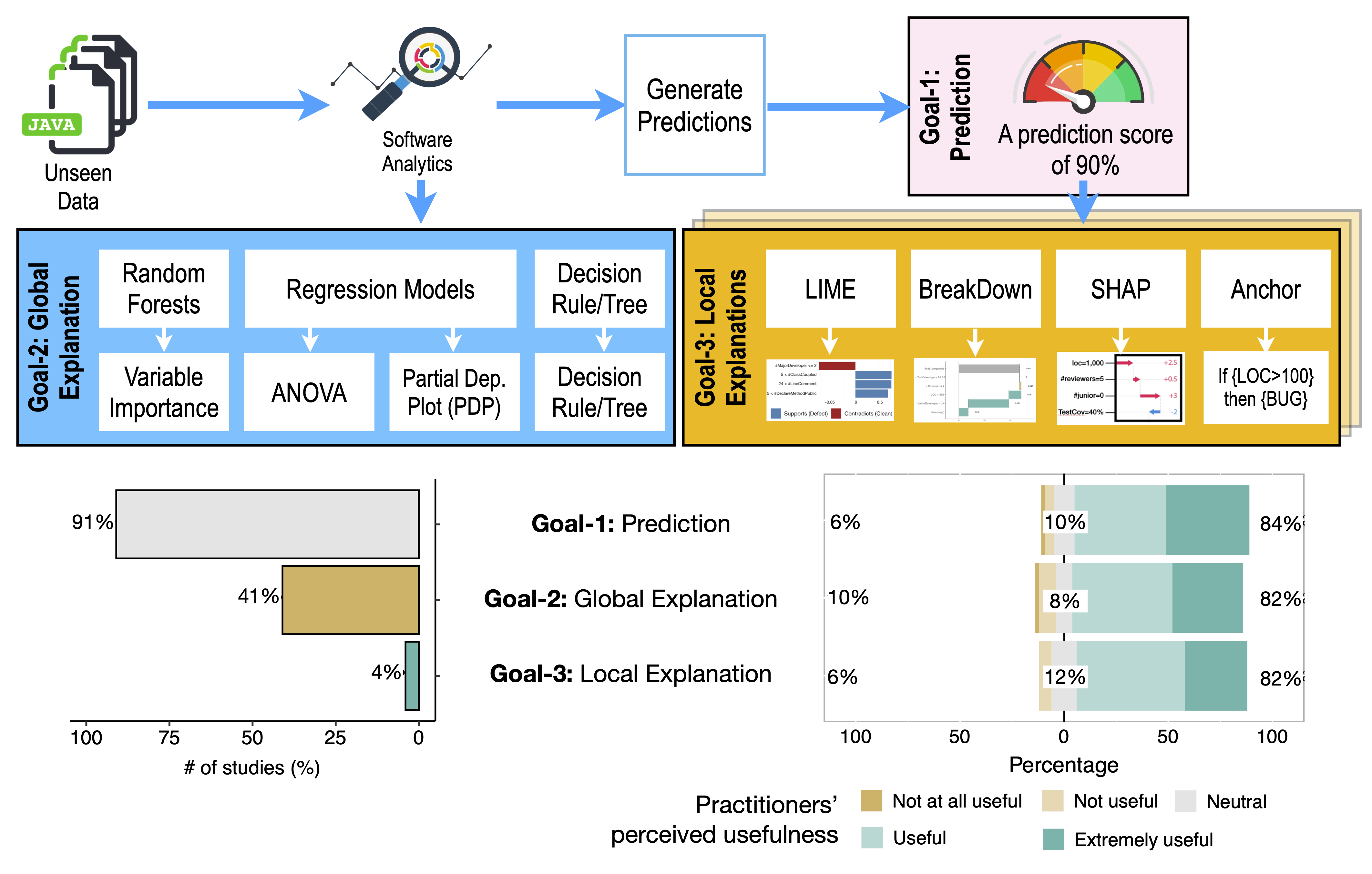Explainability in Software Engineering¶
Software engineering is by nature a collaborative social practice. Collaboration among different stakeholders (e.g., users, developers, and managers) is essential in modern software engineering. As a part of the collaboration, individuals are often expected to explain decisions made throughout software development processes to develop appropriate trust and enable effective communication. Since tool support in software development processes is an integral part of this collaborative process, similar expectations are also applied. Such tools should not only provide insights or generate predictions for recommendation, but also be able to explain such insights and recommendations.
The Prevalence of AI in SE¶
Recent automated and advanced software development tools heavily rely on Artificial Intelligence and Machine Learning (AI/ML) capabilities to predict software defects, estimate development effort, and recommend API choices. However, such AI/ML algorithms are often “black-box”, which makes it hard for practitioners to understand how the models arrive at a decision. A lack of explainability of the black-box algorithms leads to a lack of trust in the predictions or recommendations produced by such algorithms.
Lack of Explainability and Trust¶
While the adoption of software analytics enables software organisations to distill actionable insights and support decision-making, there are still many barriers to the successful adoption of such software analytics in software organizations [DTG18].
First, most software practitioners do not understand the reason behind the predictions from software analytics systems [DTG18]. They often ask the following questions:
Why is this person best suited for this task?
Why is this file predicted as defective?
Why is this task required the highest development effort?
Why should this task be done first?
Why is this developer predicted to have low productivity?
How can we improve the quality of software systems in following iterations?
These concerns about a lack of explanation often leads to a lack of trust and transparency, hindering the adoption of software analytics in practice.
Second, software practitioners are often affected by the decision-making from software analytics. Our recent work also found that practitioners are very concerned about their privacy and fairness if defect prediction models were deployed in practice. Practitioners even asked “Would developers be laid-off due to the use of defect prediction models for identifying who are most likely to introduce software defects?” [JTG21]. Article 22 of the European Union’s General Data Protection Regulation (GDPR) states that the use of data in decision-making that affects an individual or group requires an explanation for any decision made by an algorithm. Unfortunately, current software analytics still often do not uphold privacy laws [JTDG20b]. Thus, the risks of unjustified decision-making of software analytics systems can be catastrophic, leading to potentially erroneous and costly business decisions [DTG18].

Fig. 8 Most software analytics (i.e., defect prediction) studies have three main goals: (1) predictions; (2) model explanation; and (3) instance explanation. We found that 82% of our study respondents perceived the explanability goal (generating model explanations and instance explanations) is equally useful as the prediction goal. However, we found that 91% (81/96) of defect prediction studies only focus on the prediction goal, and as few as 4% of defect prediction studies focus on the explainability goal.¶
Is the Community Moving to the Right Direction?¶
Researchers’ Focuses¶
We conducted a literature analysis to better understand what researchers are currently focusing on for defect explanation. We collected 96 primary defect prediction studies that were published in top-tier Software Engineering venues (i.e., TSE, ICSE, EMSE, FSE, and MSR) during 2015-2020 (as of 11 January 2021). We then characterized the key goals of each defect prediction study into three main goals: (1) predictions; (2) model explanation; and (3) instance explanation [JTG21] (see Fig. 8). We found that 91% (81/96) of the defect prediction studies only focus on making predictions, without considering explaining the predictions. As few as 4% of the defect prediction studies focus on explaining the predictions of defect prediction models. This indicates that the explainability and actionability of software analytics is still very under researched.
Practitioners’ Needs¶
We conducted a qualitative survey to better understand what practitioners perceive as the usefulness of each goal of defect prediction models. We found that practitioners perceive that the explainability and actionability of software analytics are as equally useful as the predictions [JTG21]. 82% of our respondents said that the explanability goal (generating model explanations and instance explanations) is as useful as the prediction goal (see Fig. 8). Thus, we argue that explainable and actionable software analytics is urgently and critically needed. The research and practice communities should thus start answering the key question: “How can we make software analytics more explainable and actionable?”.
Note
Parts of this chapter have been published by Jirayus Jiarpakdee, Chakkrit Tantithamthavorn, John Grundy: Actionable Analytics: Stop Telling Me What It Is; Please Tell Me What To Do. IEEE Software 38.4 (2021)”
